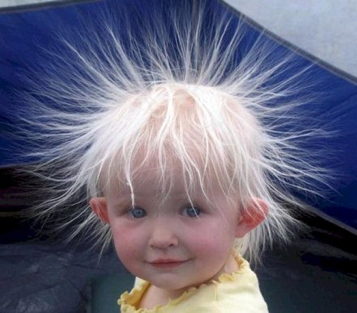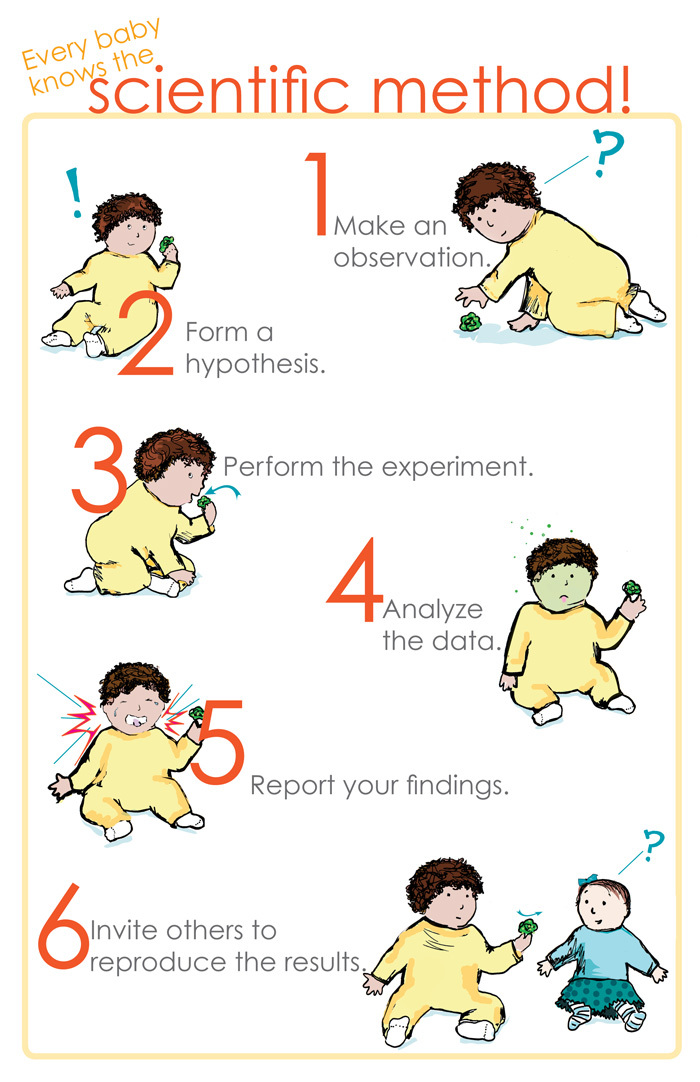Lesson 4: The "S" in STEM - Science in Early Childhood
Attention

Learning Outcomes
Upon completion of this lesson's material, students will be able
- Describe strategies for encouraging science exploration in early childhood education.
- Discuss the connection between science inquiry and intentional teaching practices for extension of learning
- Use observation to inform lesson planning.
- Create a purposeful Science lesson plan based on children’s interests or goals.
- Implement lesson plan.
- Reflect upon lesson planning implementation and use it as an opportunity for growth.
Teaching
What exactly is science and what does that look like in early childhood?
Science is a way of thinking. It is about observing, wondering, and experimenting. Infants have an innate need to explore and make sense of their world. They are born with a natural curiosity and start with observation. How many of you have seen a baby do exactly what is in the picture below? THIS IS SCIENCE in its most basic form.

Research is telling us that children have very few opportunities to engage in science learning as they grow. This is impacting children’s understanding of science skills and concepts before they enter school. If babies are born natural scientists then what are we, as early childhood educators, going to do to enable these skills to ensure success as they develop?
Strategies for toddlers are simple:
- Provide materials for them to explore
- Join them in exploration
- Connect their experiences to what they have done or experienced before
- “Phew! We ran really fast to the door when it started raining. But we didn’t make it! We got all wet, just like this morning when your mom dropped you off.”
- Ask questions that utilize their five senses will help solidify their thoughts and engage them further
- How does that feel?
- What does it look like?
- How does it smell?
- How does it taste?
- How does it sound?
- Ask I wonder questions
- I wonder what will happen if…..
- I wonder what will happen next…..
- Describe what is happening and use juicy words
- Ex – Wow! When I put the yellow water in the red water it made orange! The colors fused together!
- Did you see how the ball rolled fast down the steep ramp?
These same exact strategies can be used for all children. All you have to do is word things to challenge a deeper level of thinking and use more complex, developmentally appropriate materials and activities.
In the Maine Early Childhood Learning Development Standards Science is broken up into:
- Physical Science
- Early Science
- Life Science
Each Science is a critical component of early childhood education. As you familiarize yourself with the indicators in the guidelines, it is easy to see how each science is already incorporated within your day. What may be lacking is the intentionality and opportunities for extension. For example:
In your early childhood environment the children are very interested in mud outside. You cannot get them to stop playing in it as they enter and depart the classroom and it is a pain to clean up the classroom floor ten times a day. What on earth (see what I did there?) are you going to do????? Here is what you do – Mud is a part of EARTH SCIENCE. It is right on page 75 of the Development Standards and you can create a science activity based on something they are interested in. This is what we call a teachable moment.
Then you can plan an experiment! You could put dirt in the sensory table and let them mix water in it. You set aside bucket of mud and observe what it looks like each day and talk about how it is changing. For more advanced children you could put a bucket of mud in the sun, a bucket of mud in the shade and a bucket inside and talk about the differences. |
The whole point being that science is a vital part of education and early childhood is the perfect place to grow inquiry and teach science. We are planting the seeds (pun intended) for children to understand and develop science skills that will help them be successful as a lifelong learner. It does not have to be hard. Do not over think it. Find the natural science that is already happening and turn it into intentional practice.
Assessment
Lesson 4 Quiz
Watch this video!
Based on this video, answer each of the following questions in paragraph form:
- Summarize the strategies used to encourage science exploration
- How were opportunities for inquiry missed and what kind of questions could have been asked to enhance her exploration.
- What Science indicators in the Infant Toddler Guidelines and/or Maine Early Learning Development standards are being met?
Lesson 4 Assignment
Part 1: Observation and Planning
A key component to your Practicum experience is to engage in the process of observing, planning, implementing and reflecting on lessons.
Below you will find instructions on each step of this process. During the First part of this assignment you will first, complete an observation. At the end of the observation in the space provided you will reflect upon your observation using the prompts below. You will then use this observation process to create a lesson plan. You will be using specific forms that we have created to do this.
- Observation
- Using the anecdotal form provided, observe children for 20 minutes who are engaged in an activity. This could be a planned activity (large group or small), free play (outside or in) or another time where you think you might capture children using their natural science skills.
- In the comments section of the anecdotal recording form, jot down specific examples of how inquiry was used and how it relates to science.
- From your observation, what do you think the children are interested in or could use more support in?
- What activity will you create to support that interest or skill you observed?
- Planning
- Create a lesson plan using the lesson plan format provided
- Assure that the lesson plan is derived from the observation you took!
- Check with your cooperating teacher and/or instructor to see if it is a good fit for your placement.
- Lesson Plan Format - MS Word
- Lesson Plan Format - PDF
- Observation and Planning Lesson Plan Grading Rubric - PDF
Put all of these documents together and submit them to the "Lesson 4 Assignment - Part 1" Drop Box
Part 2: Implementation
In this second part of the assignment you are expected to actually implement the Lesson Plan you created in the first part.
- Implement the Lesson Plan
- Be sure to check with your cooperating teacher on a time and day!
- Also check with the cooperating teacher to be sure this is a fit for teh curriculum.
- It is possible that you will be observed (or recorded) during one or all of your lesson plans. Be prepared!
- Complete reflection/analysis using the format provided.
- Your reflection should be THOROUGHT.
- Ask your cooperating teacher for feedback.
- There are no "wrong answers" when you reflect. You are graded on your ability to reflect and GROW through the process of reflection.
- Reflection Format - MS Word
- Reflecton Format - PDF
- Reflection Grading Rubric - PDF
Submit this to the "Lesson 4 Assignment - Part 2" Drop Box
Possible Class Discussion
How do the science inquiry strategies in the lesson plan relate to the strategies for extended learning in the text Powerful Interactions?
Possible Class Discussion
Where can you find science indicators in the Infants and Toddlers Guidelines? List two indicators and explain how it is science.
